Sheldon Historical Society
The “Country Store” represented the social center of early Vermont communities and populated the maps in abundance. Before the advent of regular automobile use, country stores appeared at most “Corners” in rural communities. Only the Community Churches superseded the stores as focal points for community activity and conversations. The Sheldon Historical Society Museum’s “Country Store” focuses on the first use for our building as a “Country Store”, combined with the Post Office and the Town Office.
The Early Merchants of Sheldon Springs
The first established mercantile locations in Sheldon Springs appeared when the village bore the name of Olmsteadville. The official date for the change of name to Sheldon Springs occurred on March 17, 1884. Pioneer families proved to be self-sufficient with the occasional purchase and/or bartering of milk, eggs, or butter. Established mercantile locations begin to appear around 1845 when Henry Mower built his first general store. Travelling merchant wagons and infrequent trips into St. Albans or Swanton provided needed sundries. Each village otherwise proved to be self-sufficient.
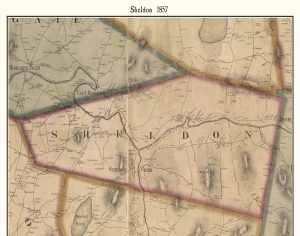
Early Merchants –Smith Olmstead – George Bancroft – Dodge
The 1857 Walling’s Map of Olmsteadville shows two saw mills and one grist mill as active businesses. Major Sheldon built the first saw mill here in 1792 capable of cutting 15,000 feet of lumber a day. He sold out to Smith Olmstead. The ownership later went to JS and FE Dodge George Bancroft owned the Lime Kiln and quarry and manufactured lumber, shingles and lathes.The Olmstead’s heavily invested in early Sheldon having purchased most of the land in what is currently Sheldon Springs. A Olmstead owned the grist mill. Numerous land transactions, store receipts, and limited newspaper proof supports a very active community. A search of land records and old newspaper articles indicates a store selling “Flour – Grain – Feed – Lumber – and – Shingles” began doing business associated with the Bancroft Saw Mill owned by George and Caroline Bancroft.
Beers Map of Sheldon Springs – 1871
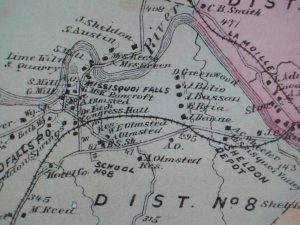 By comparison the Beers map of 1871 shows a prosperous community. Included within the map are: The Congress Hall, The Springs, The Store, two saw mills, a grist mill, a lime kiln along with residences for Olmstead, Bancroft and Dr. Fitch. Note that it was still called Olmstead Falls P.O. and that the railroad exists. By comparisons on the village map of today this area would include Mill Street from Rte. 105 to Rte 105, the Shawville Road from Rte. 105 to the bridge, as well as other streets no longer in existence.
By comparison the Beers map of 1871 shows a prosperous community. Included within the map are: The Congress Hall, The Springs, The Store, two saw mills, a grist mill, a lime kiln along with residences for Olmstead, Bancroft and Dr. Fitch. Note that it was still called Olmstead Falls P.O. and that the railroad exists. By comparisons on the village map of today this area would include Mill Street from Rte. 105 to Rte 105, the Shawville Road from Rte. 105 to the bridge, as well as other streets no longer in existence.
The Mower Store 1840s to 1899
Henry and his wife Martha arrived in Sheldon in the mid-1800s and lived here the rest of their lives. Born to them were Harlow Mower who became a renowned businessman, Arthur Mower who died in 1910 at a young age and Lillian Mower “Machia” who later in life moved with her husband William to Massachusetts where Harlow is noted to have visited in the mid-1950s. Henry and Martha were the grand parents of Grace Mower Winchester the long time town clerk and treasurer of Sheldon known to many people still living in Sheldon.
Henry Mower built a store in what is now known as Sheldon Springs. The 1871 map showing the store on the NW Corner in the village signifies that it was mapped after Henry moved the store in 1867. In 1868 Henry’s store stood on the location noted as the Congress Hotel. In 1868 he and a group of other land owners conglomerated 250 acres of land on the SW corner of Main St. and Shawville Road and sold it to one Samuel Fitch of New York City who then built the Congress Hall. In order to accommodate the sale Henry moved the store using oxen to the opposite side of the road. Harlow Mower, his son, recounts riding on the skids of the sled with his brother Arthur while the store moved from the south side of the road to the north side. During the move Harlow noted that an earthquake struck. Oxen pulling a building would likely occur in winter which coincides with this reported quake.
Research of Vermont earthquakes at that period of time shows:
“On December 18, 1867, a frightening earthquake was centered probably in northern New York. It shook Burlington for about 25 seconds and was felt throughout all of Vermont, although no confirmed damage was reported.” https://nesec.org/vermont-earthquakes/
This original store apparently burned in 1872… Henry’s new store built around 1877 occupied the site that continued to be a store until 1983. After rebuilding the store Henry became ill. Harlow returned from Massachusetts where he went to learn the retail trade as an apprentice. Harlow and his brother Arthur returned to Sheldon and took part in the family business. Neither Harlow nor Arthur appeared to enjoy the enterprise with their father who may have been less than congenial. Henry elected to go into partnership with his son-in-law and daughter William W and Lillian M Macie. On Jan 13, 1899 after Henry died, (August 12, 1898- age of 55), his wife Martha sold the property and business to the Macias
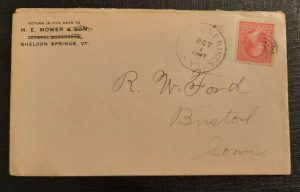
This 1897 postmarked n Oct 1 shows that the “& Son” had been scratched out. Perhaps this could be an indication of some family turmoil.
The Whittemore Store Mystery
One existing historic artifact in the possession of the Sheldon Historical Society is a ledge known as the “Whittemore” ledger for the “Whittemore Store” in Sheldon Springs with recordings from 1845 to 1847. A thorough search of land records, birth and death records and personal information along with an Internet search resulted in no additional information to support the existence of a “Whittemore” Store in Sheldon. Henry Mower, discussed above, remains the only verifiable general merchant during time frame of 1845 to 1847
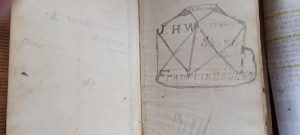 The cover appears torn off the book while the first pages carry the names of two Whittemores. The first is E. W. Whittemore Sheldon Springs VT but also the date Oct 31, 1886. The second is J. H. Whittemore, Sheldon Springs, VT Franklin County with a sort of vest on it. From the last ledger entry to the end of the book the pages contain many “child” drawings. Lucy Sheldon (1836 to 1886) married Charles Henry Whittemore. Two of the male offspring were Edward Winthrop Whittemore and John Harding Whittemore. Although coincidence may exist here, the evidence points to the ledger of Henry Mower falling into the hands of the Whittemore children. The unanswered questions warrant additional research.
The cover appears torn off the book while the first pages carry the names of two Whittemores. The first is E. W. Whittemore Sheldon Springs VT but also the date Oct 31, 1886. The second is J. H. Whittemore, Sheldon Springs, VT Franklin County with a sort of vest on it. From the last ledger entry to the end of the book the pages contain many “child” drawings. Lucy Sheldon (1836 to 1886) married Charles Henry Whittemore. Two of the male offspring were Edward Winthrop Whittemore and John Harding Whittemore. Although coincidence may exist here, the evidence points to the ledger of Henry Mower falling into the hands of the Whittemore children. The unanswered questions warrant additional research.
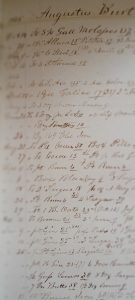 This ledger page shows purchases by Augustus Burt. Others customers Included: Peter Sturges, Richard Stattuck, John Fish, Benjamin Fish, Samuel B Sheldon, Rebecca Ruthford, Levi Fairchilds as well as the Fairchilds & Co. account. Many of the names connect directly to Sheldon, however, a research through public records conducted on the first 100 name revealed only 35% being of Sheldon origin. Others proved to be from Fairfield, Highgate, and Enosburg
This ledger page shows purchases by Augustus Burt. Others customers Included: Peter Sturges, Richard Stattuck, John Fish, Benjamin Fish, Samuel B Sheldon, Rebecca Ruthford, Levi Fairchilds as well as the Fairchilds & Co. account. Many of the names connect directly to Sheldon, however, a research through public records conducted on the first 100 name revealed only 35% being of Sheldon origin. Others proved to be from Fairfield, Highgate, and Enosburg
Further genealogical study points to one Whittemore family coming from England to Connecticut in the early 1700s. According to the post, all of the Whittemore ancestors stems from this one family. Additionally the individuals cited in the ancestry mostly came from professional backgrounds such as doctors and lawyers not merchants.
